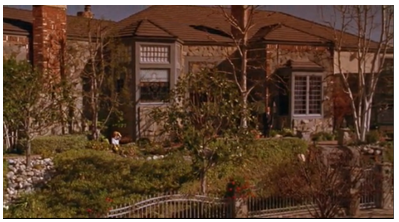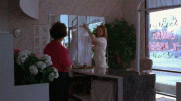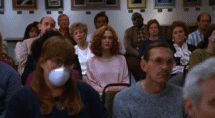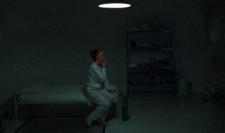The concept of place can be used in different areas of art such as literature and cinema though space is explained in the literature with the help of appropriate clusters and stylistic devices while cinema enables the audience to see the space and better comprehend the situation. Sometimes, movies are filmed in a single room to demonstrate the isolation and pressure experienced by the character/characters.
At the same time, huge spaces can symbolise isolation and alienation which serves as a basis for the character’s problems, conflicts, and self-analysis.
The movie Safe (1995) directed by Toddy Haynes and starring Julianne Moore is aimed at making people aware of the hazards brought by the chemicals that surround us and the loneliness of the main character who is forced to search for salvation on her won due to lack of understanding and support from society.
The space and place create a multidimensional movie where one can see something similar to his/her life and experience the full range of emotions and feelings perceived by the main character.
The space in the movie is used to introduce the problems of the main character, a homemaker Carol White who finds herself in an uncomfortable position when she finds out that she is allergic to almost everything that surrounds her in everyday life. The perspective is varied to show how the character perceives herself towards the social medium and the real situation that surrounds her.
The opening scene of the movie shows us the main character having sex with her husband when he comes from work. This is a natural process for many couples and such scenes appear in many movies. However, the way these two characters were shown makes the audience see that they have problems, particularly that the female character (we do not know her name from the very beginning) has some problems in terms of intimacy.
The place is ordinary for such a scene (a bed in the bedroom) but we cannot see anything but her lying on her back and her husband is trying to satisfy his natural needs. She is depicted as unemotional and statue-like. This can be regarded as the first function of space in this movie as it helps to see the relations between the main character and her husband.

The relationships with Carol White’s husband are depicted in the background of her conflict with the self and the surrounding atmosphere. The places when these two characters are shown include the house and the garden making the audience aware of the limited number of places where they meet each other.
However, when Carol finds out about the organisation of other people who have problems similar to hers, her husband tries to support her and they are depicted having conversations in the special centre broadening their usual area of relationship.
It is also necessary to draw your attention to the space of the movie in terms of the relationship between Carol White and her husband Greg; the mirrors create additional space that reflects the existing world and emotions but prevents characters from perceiving it.
In this respect, a huge house makes us think about the tiny person in it while the space is enormous but she cannot cope with all the problems occurring in it because it is too large for her.
The meaning of the space is partially metaphorical in this movie because it symbolises the character’s feeling of not being safe when she communicates with others, looks at her reflection in the mirror, and does ordinary things that used to be integral parts of her life.
The function of mirrors contribute greatly to the understanding of the concepts of space and place in the movie because this reflecting objects that we can see in the bedroom of main characters reflect the bed and create the illusion of space though this is simply an illusion.
The mirrors depicted in the bedroom do not mean that the designers of the interior made a mistake but contribute to the feeling of loneliness perceived through the screen.
Nevertheless, the illusion of space created with the help of reflecting mirrors serves to make the space even greater within this huge house and increase isolation of the main character. Another important aspect of reflections that can be considered a part of the space/place function is that some problems that occur
Another function of space in Safe (1995) is the interactions with the social medium which includes friends, people at work, and strangers. Sorlin suggests the context that occurs when the place is identified in the space in cinema (25). In this respect, place within a movie space implies a social context for some actions that take place.
As such, social relations and interchanges take place and shape the entire scenes contributing greatly to the impression created by the movie on the audience. When the audience can understand exactly what the author wanted to show and what message he/she wanted to convey, it is easier to become involved into the discussion of other aspects discussed in the movie.
In this respect, the social relationships should be understood to enable the audience become aware of the background and not to be distracted while watching it with regard to the events occurring on the screen. The interactions with other characters in the movie occur in places while the entire basis for these events/interactions is the space of the movie.
The problems discussed in the movie Safe (1995) pertain to the globalisation and technological advancement, changes and pollution, the chemicals and ordinary lives of people that breath those chemicals in. The simple permanent dyeing becomes a kind of deadly procedure that leads to nose bleeding of Carol when she decides to have a perm. The moment when her hair is treated with the chemicals, we can see her head as if this can result in something negative.

At the same time, she can see her own reflection in the mirror and only then has a nose bleeding which may be treated as the symbolic reflection of her inner conflict which can be seen only in the mirror as a means of self-analysis.
McGee analyses the urban space as the reason for problems that may occur with the characters; she dwells on “habitation, on place and non-place, from the aggressiveness that comes from the outside/inside dichotomy and on the urban milieu” as the modern sources of conflicts (46).
In other words, the large city is contrasted to the desert where the special centre is situated and where Carol finally finds some answers to her questions because the centre is basically aimed at helping people gain understanding of themselves and their needs to prevent the problems in future.

The dramatic space is created in the movie with the help of varied perspective which is either deep-focus or general. As such, we can see the deep-focus perspective when Carol watches at herself in the mirror and possibly starts thinking about her loneliness and lack of understanding and support from others.
Also, a deep-focus perspective is used when Carol seems to find a solution to her problems in the form of the special centre where people have similar problems. The note left on the board notifies that there are others who suffer from increased sensitivity.
The general perspectives are used either when Carol is involved in social interactions such as training, going to the dry-cleaner’s, visiting the session in the special centre, or when Carol is alone and she does not feel comfortable. For instance, the general perspective can be considered a great way to introduce the narrative effectively and demonstrate the whole range of methods and images chosen for the scene.
When Carol is shown doing her routine business, she does not demonstrate any signs of allergy or anxiety whereas some time later she appears to be a completely different person. Some of the explanations may suggest that the main character is confused to the extent that she starts to believe that she cannot live like normal people and that she needs special conditions.


The social interactions can be seen through the communication of the main character with her friends whom she leaves at a distance, her husband who is more distant from Carol than her friends, and her new ‘friends’ who simply have similar problems and claim to understand her. All these interactions are shown through space and place concepts as the main contributors to the emotional message of the movie.
The scenes where she is with her friends and does her routine jobs are placed into neutral environments such as the gym or dry-cleaner’s. At the same time, she does not feel happy while doing her daily jobs and meeting her friends.
It seems that she is bored which can be seen from the mood created through the perspective when general perspective is used for the life of which she has bored, the routine, the similar actions she makes, and deep-focus perspectives are used to indicate her condition when the ‘illness’ is revealed and changes in her condition.
However, the perspective of the final scene should in some way demonstrate the recovery while the general perspective is used in it and it seems that this condition would be her permanent one for the rest of her life.
The perspective can also be used to make the audience closer to the character and make the environment more intimate, to show that the problems that occur are not displayed by people in everyday lives and we should be careful with discussing them.
Browne reports that the process of “’inscribing’ the spectator’s place on the level of the depicted action, has the effect of making the story seem to tell itself by reference to an outside author but to a continuously visible, internal narrative authority” (472). At the same time, we can see the isolation even more obviously when we watch from the deep-focus perspective and notice every gesture and every emotion of the main character.
The deep-focus perspective, in this case, is used to show the changes that occur and the process when they occur rather than the effect of changes. In other words, the process of changing perception is depicted using the deep-focus perspective while the neutral states and the effects of the changed perception are demonstrated with the help of the general perspective.
The changes in the main character can be seen in every stage of the movie and in different places which can be interpreted metaphorically as everything changes and a person can obtain a completely different attitude towards people, places, and activities that seemed to be absolutely normal previously.
She gets pale and sick; her interest to life seems to decrease every minute; the audience can see the changes through the space used by the director to show the emotional pressure and exhaustion of the main character.
The film is aimed at depicting the power of autosuggestion that is strengthened with the help of the social environment. In this respect, we can see the contrasts when the deep-focus and general perspectives are varied in order to show the cause-and-effect relationships.

For instance, when Carol attends the seminal of this special centre, she is depicted in the interrelations with the social medium as in the picture, while the TV-set is shown using a rather deep-focus perspective when the camera moves to demonstrate the changes that occur in the consciousness of the main character.

The function of place in the Safe (1995) is more generalising and aligning rather than provocative and astonishing. The places are ordinary and usual for general audience except for one. The place where the main character sits on the bed is used in the final scene of the movie where Carol takes the oxygen cylinder puts on a mask and starts to breath.
The scene is filmed using a general perspective though there are no details that would distract the audience from the major actions that are aimed at showing that she can cope with all her problems.
The dark and a bit smoke background and colours of the room in combination with the major objects depicted including the spot of light that comes from the lamp on the ceiling, a bed on which the main character sits, and other stuff used to create the overall environment of the room are used to show that the grey is not very bad when you have already seen the black.
The varied perspectives enable the audience to see how the narrative can be better perceived through different types of perspectives used to convey the emotional state of the main character and the changes that occur with regard to the places in which the events happen.
The entire film contains no 360° perspectives but it has many shifts when the camera switches from showing the frontal line to the back perspective when the audience can see what is happening in the back. At the same time, the switches were used when the camera showed the audience of the seminar/session demonstrated in one of the pictures above and the TV-set.
As such, we could see how that distance changes between the characters and the audience. The entire story can be told with the help of shifting perspectives and views that enable the audience to see the changes. As a rule, the movement symbolises changes though the varied perspectives used in the film demonstrated the changes and their results, the process and effect, the previous condition and the current one.
With the help of shaping the space we create distance and enable the characters to become closer to each other or, on the contrary, to leave places that are not pleasant for them. As claimed in the book by Konstantarakos, “space can be seen to contribute to the dynamics of the narrative and can be shown to play an important part in the development of a variety of considerations, both ideological and artistic” (1).
The dynamics of the space are seen through different perspectives applied to the same places in different moments of the changes that happened in the life and perception of the main character. The simplicity of forms and shapes as well as lighting used in the movie contribute greatly to creation of the image of routine at the beginning and, when the colours become darker and more resemble grey, in the end.
To conclude, different perspectives used in the film contributed to the understanding of the dynamics of it with regard to the story told. The main function of space in this movie is demonstration of alienation and isolation of the main character when her perception of the outside world starts to differ from the one of her friends and husband.
Carol White is shown as a person who is confused and finds no support from her family while strangers seem to be friendly only because they have similar problems. All these issues are demonstrated with the help of the space and place that are shown from different perspectives and varied focus.
Works Cited
Brown, Douglas, and Tanya Krzywinska. ‘Movie-games and Game-Movies: Towards Aesthetics of Transmediality.” Film Theory and Contemporary Hollywood Movies. Ed. Warren Buckland. Taylor & Francis, 2009 86-103. Print.
Browne, Nick. “The Spectator-in-the-text: The Rhetoric of Stagecoach.” Movies and Methods: An Anthology, Volume 1. Ed. Bill Nichols. University of California Press. 458-476. Print.
Konstantarakos, Myrto. Spaces in European Cinema. Fishponds, Bristol: Intellect Books, 2000. Print.
McGee, Laura. “Space, place, and identity in Andreas Dresen’s Night Shapes, the Last German ‘City Film’ of the Twentieth Century.” Revisiting Space: Space and Place in European Cinema. Eds. Wendy Ellen Everett and Axel Goodbody. Bern: Peter Lang, 2005. 37-47. Print.
Sorlin, Pierre. “Urban Space in European Cinema.” Revisiting Space: Space and Place in European Cinema. Eds. Wendy Ellen Everett and Axel Goodbody. Bern: Peter Lang, 2005. 25-37. Print.